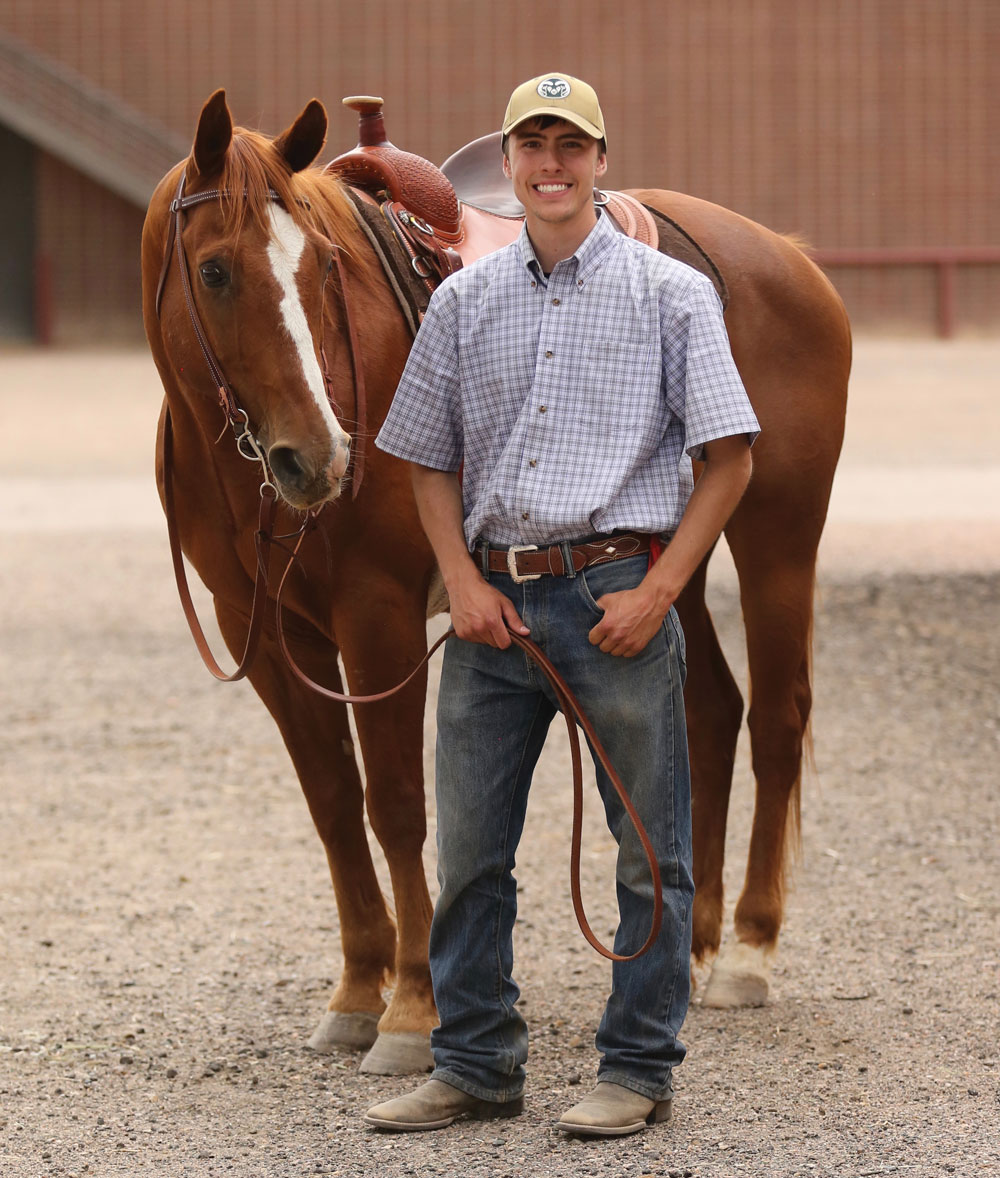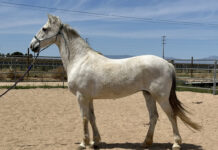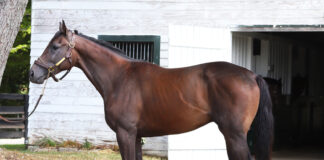
Forrest Czarnecki arrived at Colorado State University (CSU) to prepare for a career in journalism, but now he’s also pursuing secondary studies through the school’s Right Horse program, designed to help horses in transition find new careers. As part of the CSU Equine Science curriculum, the program matches students with horses at the Temple Grandin Equine Center for a semester or two. After they get their training, the horses move on to new careers.
But there’s a twist. In addition to teaching students to train the horses, the CSU program was developed to teach students to assess the horses and then provide the most appropriate training in order to make sure they match their new careers perfectly.
“We’re creating scientists, not just trainers,” says D. Adam Daurio, Esq., director of administration and outreach for the Temple Grandin Equine Center at CSU. “They can evaluate the horses for what their best use will be and train them, whether they’re saddle horses, trail horses or horses used in equine assisted activities and therapies [EAAT].”
The CSU Equine Science Program is a four-year degree program that balances rigorous biological sciences coursework with business electives and hands-on experiences with horses through labs and internship opportunities. Students who pursue a degree in equine sciences graduate with a Bachelor’s Degree, according to instructor Sharon Butler, DVM, a certified therapeutic riding instructor and teacher of equine sciences in the school’s Animal Sciences Department.
After graduation, students may continue on to veterinary school, work for feed manufacturers, become equine equipment developers, or serve as ranch managers, riding instructors for EAAT, or summer camp directors, according to Butler.
“Graduates may also work on breeding farms or as trainers,” she says.

The New Program
CSU’s Right Horse program began as a pilot program offered to equine science students as an independent study course. From October 2017 through May 2018, students involved in the pilot worked with six horses that came to CSU from the Dumb Friends League Harmony Equine Center in Franktown, Colo.
Participating students were taught to assess the horses in order to determine what second career would best suit each animal. The students were then taught how to train the horses for specific second careers. The horses included warmbloods, Quarter Horses, draft horses, Thoroughbreds and ponies.
The goal makes the program unique, according to Daurio. “Most students are taught to train young horses, but they are not taught to evaluate and train horses in transition,” he says.
That’s because horses in transition represent specific challenges to those who would train them for new careers—and ultimately for adoption.
“When horses are young, you don’t you don’t have to worry about remedial training,” says Daurio. “Students [in this program] think about what really is best for this horse’s future use.”
But first, students must discover facts about the horses’ past lives. Some of the horses that come into the program have been surrendered to the Harmony Equine Center by their previous owners. Others come through Harmony after they have been seized from previous owners after law enforcement actions.
“When the horses arrive, we assess their behavior as well as their skills to see what kind of groundwork needs to be done,” says Tim Jedra, an adviser and instructor in the school’s Equine Science Department, who teaches students in the Right Horse program how to evaluate horses coming in to the program. “We want to be sure that [in the end] the horse are placed in the best situation.”
Still, facts about the horses’ pasts are usually scarce. It’s that lack of information that makes the students’ work challenging, says CSU graduate Kylie McGarity, who served as the student coordinator for the school’s Right Horse pilot program.
“You don’t know the background of the horses that come through a rescue, so when we get them, I assume that they’ve had no training,” McGarity says. “The first time I take a horse into the round pen, I let them know that if they stick with me—if I’m their leader—then everything will be OK.”
Most often, students are assessing horses to see if the animals might be used in EAAT programs at CSU and elsewhere.
“EAAT is growing at a rate of 300 percent a year, so our goal is to get more therapy horses,” says McGarity, who has been hired by the school to work in its Right Horse program. “But not every horse is going to be a therapy horse.”

Cues from the Past
Students in the Right Horse program at CSU learn to pay attention to cues that the horses give about the kind of jobs they had in the past, and how they might be used in the future.
“You have to listen to the horse [and] they’ll tell you what they’re best suited for,” she says. “I see how they respond to different kinds of [training] pressures.”
At the same time, students expand their knowledge of a variety of disciplines in order to make the best activity match for the horse.
“Some people are good at one particular discipline, but you have to be familiar with them all,” says McGarity. “Ultimately, you have to know what makes a good dressage horse, a good trail horse or a good therapy horse.”
Keeping up with Demand
In the fall, what’s now known as the Right Horse program at CSU will become part of the school’s Equine Science degree. Those who complete the coursework will earn a Bachelor of Science degree in Equine Science with a certificate in EAAT or in Training Horses in Transition. So far, 20 students are already signed up to take the course.
“We have students lining up,” says Daurio. “And we haven’t even promoted it to students yet.”
And not a moment too soon. According to Daurio, the Great Recession decimated breeding programs nationwide, beginning in 2008. At the same time, demographics of those participating in equestrian sports started changing.
“As a result, we don’t have the number of well-bred horses in the industry that we used to have,” he says. “The Baby Boomers are getting older, and young people are outgrowing their horses, changing disciplines or getting out of equestrian sports altogether. We don’t have the number of well-bred horses in the industry that we used to, [but] we have many more horses in transition.”
For Czarnecki, the value of what he’s learned is even more simple than that.
“You are so happy when you get the horse-human connection and elated that you’re helping horses have a future,” he says. “Ultimately, we take care of the horse and the horse takes care of people.”
This article about horse training at Colorado State originally appeared in the August 2018 issue of Horse Illustrated magazine. Click here to subscribe!





